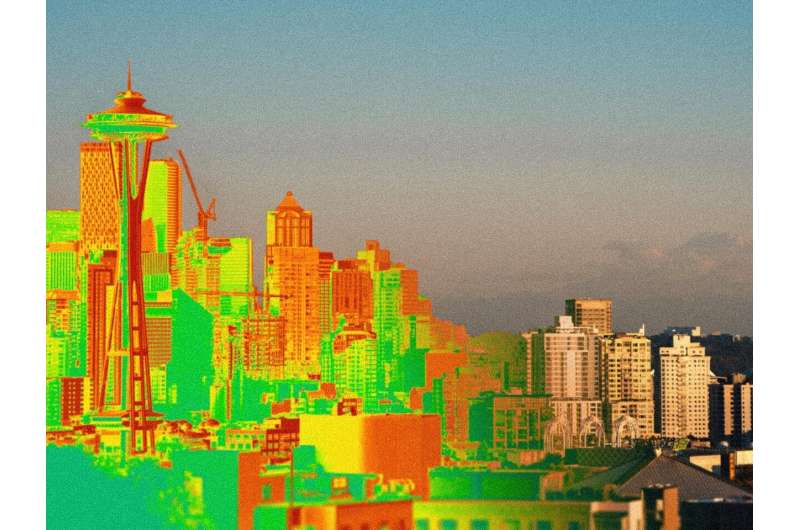This article has been reviewed according to Science X's editorial process and policies. Editors have highlighted the following attributes while ensuring the content's credibility:
fact-checked
peer-reviewed publication
trusted source
proofread
Supercharged heat waves like Washington's deadliest will strike harder and more often, study says

North America's 2021 heat wave was Washington's deadliest weather-related disaster, claiming over 100 lives in the evergreen state and many others in neighboring regions. Scientists not only suggest that such heat waves will grow more intense and strike more often—in new work published in npj Climate and Atmospheric Science, they reveal the underlying mechanism behind these strengthened heat waves.
"The scientific community has suggested for quite some time that heat waves will intensify under a changing climate," said lead author Ziming Chen, a postdoctorate researcher at the Department of Energy's Pacific Northwest National Laboratory.
"But we haven't understood exactly what is happening in Earth's atmosphere that intensifies these heat waves, nor what causes them to strike more frequently. Now, we can see which specific changes in atmospheric circulation patterns likely underpin these changes."
The authors of the new study sought to better understand how global warming affects heat domes like the one from summer 2021. The authors present their work this week at the American Geophysical Union's 2023 fall meeting in San Francisco.
Previous work by PNNL scientists suggests that current climate pledges from countries around the world are still insufficient to limit global warming to 1.5 degrees Celsius, bringing the risk of continued extreme weather. COP28—the global climate conference in which world leaders manage emissions pledges with the goal to limit warming—concludes today.
"Our new work suggests that if current emission trends continue," said co-author and atmospheric scientist Ruby Leung, "we expect these changes to boost heat wave risk over the entire Northwest region in the coming decades. Residents of California, Idaho, Oregon, Washington, and other neighboring states may experience especially strong heat waves. By better understanding the conditions that precede these events, we can all be better prepared for them."
What causes heat domes, and why are they getting worse?
The process begins with a warmer sea surface in the Pacific Ocean, heated by greenhouse gas warming and further strengthened by an El Niño-like warming pattern.
That heat gives way to convection: the air above the warmer sea surface begins to mix as warm air rises and cool, dense air sinks. This convective mixing transfers heat upward.
This convection releases heat aloft, which then gives way to something scientists call atmospheric Rossby waves. Just as ocean waves move through the sea, atmospheric Rossby waves move through Earth's atmosphere to affect weather far downstream.
Rossby waves can strongly influence Earth's climate and even intensify extreme weather. In this new work, Rossby waves play a direct role in priming the Pacific Northwest for a heat-dome-like effect, threatening the region with sweltering heat.
Heat domes happen when high-pressure atmospheric conditions become fixed over a region, refusing to budge sometimes for weeks. The high-pressure conditions create clear sky, reducing cloud cover or rain from cooling the area. By simulating Earth's atmospheric processes, the authors find that Rossby waves could come to be stationary over the Pacific Northwest more often in the future, producing a heat dome-like effect.
They also find that these stationary Rossby waves may nearly double in magnitude in the coming decades.
"Although the amplitude of the heat dome-like stationary wave above the Pacific Northwest will be roughly twice as large under a high-emission scenario toward the end of the century," said Chen, "the intensity of heat waves would increase much more than that of the heat dome itself due to the contribution of background warming and land-atmosphere interactions."
Such interactions, like how much soil moisture is available to help cool the atmosphere through evaporation, can significantly affect the local climate. In the example of the summer 2021 heat wave, said Chen, overly dry soil contributed extra degrees of heat to an already intense heat wave. Changes in wind patterns, too, could likely push Rossby waves increasingly toward North America, bringing them to strike more often.
Past research by PNNL scientists has shown that hotter summer nights can boost urban heat stress, and that residents of many U.S. cities suffer these effects disproportionately. The authors of the new work hope their results will inform strategies to help communities better prepare for extreme weather. Understanding changes in extreme weather is key, also, in building a more resilient electrical grid.
More information: Ziming Chen et al, Projected increase in summer heat-dome-like stationary waves over Northwestern North America, npj Climate and Atmospheric Science (2023). DOI: 10.1038/s41612-023-00511-2
Journal information: npj Climate and Atmospheric Science
Provided by Pacific Northwest National Laboratory




















